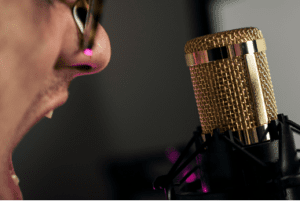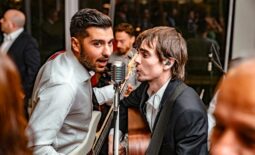Tin Ear? Don’t Fear!
How to Become a Great Singer when Auditory Learning is Not Your Style
 If you’ve tried all the traditional approaches to studying singing, and keep coming up short, this article is very likely written for you. And this was all inspired by this morning’s workout, which is for me, a notorious work-outer by necessity rather than choice, a most unlikely source of inspiration.
If you’ve tried all the traditional approaches to studying singing, and keep coming up short, this article is very likely written for you. And this was all inspired by this morning’s workout, which is for me, a notorious work-outer by necessity rather than choice, a most unlikely source of inspiration.
I was taking my online dance class, which is already a challenging experience for me at 8:00 am, when I would rather be celebrating another successful day of booting my teenager out of the house in time for school with a cup of coffee and some Wordle. But this morning, tragedy struck. Due to the magic of the Internet not caring about my mental health at all, the audio link for the music un-synched itself from the video and spoken instruction of the teacher. This situation got cumulatively worse after several video freezes, with the teacher blissfully unaware of the ensuing chaos experienced by those of us at home, particularly me. I’m a trained musician, whose life is carefully calibrated to square phrasing and strong downbeats. When choreography transitions are occurring approximately 2 3/8 measures ahead of the musical cues, it produces in my brain mass hysteria, wailing and gnashing of teeth, and the intolerable torments of hell.
I leaned in. This was my practice today, to rely solely on visual cues, ignoring what I knew to be true within the framework of the music. It was like lying. But I’m already good at active listening, so clearly the Universe was telling me I needed to work on combining visual and kinesthetic learning styles. And who knows? Maybe I’ll finally be able to parallel park now. (Implausible.)
I’ll admit, this title is misleading. I find the phrase “tin ear” to be incredibly derogatory, and I would prefer to strike it from the lexicon. According to Collins Dictionary, “if you say that someone has a tin ear for something, you mean that they do not have any natural ability for it and cannot appreciate or understand it fully.” Conservative Music Education tends to discourage learners who do not fit the mold with refined auditory learning skills. When I was in college, I watched talented musicians and promising music teachers, chock full of natural ability and appreciation and understanding, struggle through Aural Theory and singing classes, often dropping out of the program. A good ear was considered to be an absolute requirement for success, perhaps even THE absolute requirement for success.
With all due respect to Conservative Music Education and the fine people at Collins Dictionary, when it comes to singing, I could not disagree more vehemently.
Listen. (Ha! Sorry.) Having a good musical ear is a huge advantage for a singer. But it is mostly a shortcut. And like any advantage, it has a negative side. Being a kinesthetic singer, for example, has a ginormous benefit: once you are locked in, nothing will derail you, as you have muscle memory and don’t need to hear yourself to execute correctly. If, however, you are entirely reliant on how you sound, when you can’t hear yourself, you are in quite the pickle – and if you’ve ever performed at a gig where you were completely buried in the monitor mix under screeching guitars and droning keys, then a) you are like 99.99999% of the singing population, and b) you understand the value of knowing what good singing feels like as well as what it sounds like.
This is not to say that a musical ear is not worth cultivating. How many of us successfully depend on a solitary learning style to do anything? I support combining as many different styles as possible – leaning into one’s primary style as a foundation of strength, and then correlating it to others that also serve in some way. For example, I am auditory, but I also have ADHD; it’s far too easy for me to be distracted. So when I’m listening to a presentation, I also use visual anchors like transcriptions or slides to keep me from floating away, and I take notes that I may never read again, just to get a handle on the words, and get my body involved. As a singer, I strive to bolster the auditory to kinesthetic connection, so whichever techniques I need to call upon are available on demand.
When I was a college student, I once heard a great opera singer speak on his craft – I think it was Sherrill Milnes, but I cannot fact check myself, and middle-aged memory is a tricky thing; I have a vague recollection of coming up with the original idea for AOL chat rooms, which seems in retrospect to be unlikely. However, this part is indelibly locked into my memory: Sherrill or Whatshisname said that he often practiced in NYC subways, because it resembled the amount of noise that one experienced onstage, and he never wanted to rely on hearing the sound of his own voice to produce a good sound.
Of course, this guy, whoever he may have been, was a world-class singer who could be pretty confident that he was at least in the ballpark. How do the rest of us make sure that we are correctly drawing from our strengths to reinforce other learning skills?
Accountability is Key
Shocker. I teach in the real world, and very few of my students are entirely auditory learners. I have students who are working with severe hearing loss, students who need to be so literal with their practice that one alteration makes the whole song sound wrong, and students who have been written off as serious musicians because they couldn’t “just do it like this.” They all have different variations of learning preferences, which could not be more diverse. Do you want to know what they all have in common?
They all sing great.
They’ve figured it out. They have worked with their individual learning styles to develop tools that get them where they want to be. Some of them are professional musicians. One of them who was told that he “maybe just shouldn’t sing” is gigging about 4 times per week. Take THAT, Conservative Music Education.
Here are some of the Greatest Hits of what we’ve found works!
Visual Resources
Pitch recognition software – I have a student who swears by these apps. He tends to view pitch as a jumping off point for expression more than as a hard and fast rule. But as he is now a working musician with a rich catalog of original material, he needs to speak a common language with his band. This keeps him on track.
Visual metronomes – I personally love these, not just as a visual way to maintain rhythmic structure, but as a discreet and silent method of determining tempo. The one I use also incorporates a click track with a different tone for the downbeat, which lets us Audies have some fun too.
Sheet music – Most of my work in a commercial voice studio is structured around commercial practices, so sheet music isn’t often used. But when I have a visual learner, even if they don’t read music, they are usually able to follow the contours of a melodic line, and understand the distances between intervals in a way that is sensical.
Picture notes – A student and I just devised an entire series of what can only be described as hieroglyphics that she draws in her sheet music, to serve as visual cues for technical mechanics she wants to incorporate. Looks like cave drawings to me, looks like success to her. Create your own road map and shorthand.
Kinesthetic Tactics
Mirrors – The ultimate accountability tool, technically this is a visual resource, but the point is to check in for instant feedback that you are employing mechanics correctly. I am constantly amazed that the second a student gets in front of a mirror, no matter how unable they were to execute on the desired technique, it is immediately fixed.
Self-Accompaniment – One student has trouble knowing for sure that she is on pitch, except when she is duplicating her melody on piano. Then it is perfectly aligned. Our theory is that it gives her a nearly identical sound to latch onto, and that she brings her voice to tune with the instrument she is playing. Our work is to turn it into muscle memory so she doesn’t need the piano anymore, her voice just knows where to go by sensation.
Body Movement – I always say, get it in the body somewhere, and the right part of the body will catch on. It may be rolling through disco moves to promote airflow, pointing your Cyborg antenna to direct placement, or stretching an invisible rubber band to activate soft palate engagement. There is no end of crazy things that work, and if you don’t believe me, watch some live videos. All that quirky stuff you thought your favorite singer was doing for cool vibes, may actually be helping them sing better.
And of course, I propose to record everything. Review your practice and your performances, and analyze what’s going right and what needs continued attention. We are talking about supplementing our auditory skills, right? Let’s wrap them in, shall we?
So like I said at the beginning, if you’ve always heard, “just do it like this” from voice teachers with little to no success, I hope you now have some hope and validation that it is not you who is failing. Traditional ear-based approaches are failing you. Rest assured, you are heard. You are also seen and felt. Now go out there and find the accommodations that work best for you and your wonderfully unique and robust manner of learning. No gnashing of teeth required.
 Kristin Henry is a Mom, a Singer, a Reluctant Exerciser, a High-Functioning Scorpio, a Slighty Salty Hufflepuff, and a Voice Teacher at Performance High Studios. She is honored to work in harmony with the finest teachers in Denver, who share the goal of helping singers find transformation, authenticity, and delight in their voices and lives.
Kristin Henry is a Mom, a Singer, a Reluctant Exerciser, a High-Functioning Scorpio, a Slighty Salty Hufflepuff, and a Voice Teacher at Performance High Studios. She is honored to work in harmony with the finest teachers in Denver, who share the goal of helping singers find transformation, authenticity, and delight in their voices and lives.



